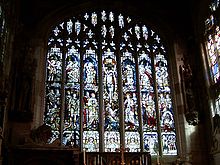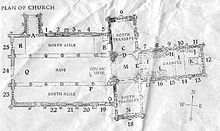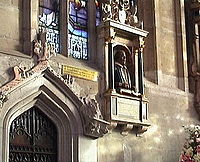- Church of the Holy Trinity, Stratford-upon-Avon
-
Holy Trinity, Stratford-upon-Avon 
Holy Trinity's east window from the exterior, depicting St AndrewCountry United Kingdom Denomination Church of England Churchmanship Broad Church Website www.stratford-upon-avon.org/index.html History Dedication Holy Trinity Administration Parish Stratford-upon-Avon Diocese Coventry Province Canterbury Clergy Vicar(s) The Revd Martin Gorick Curate(s) The Revd Margaret Sweet Laity Organist/Director of music Andrew Jones The Collegiate Church of the Holy and Undivided Trinity, Stratford-upon-Avon is a Grade I listed[1] parish church of the Church of England in Stratford-upon-Avon, Warwickshire, England.
Contents
Background
It is often known simply as Holy Trinity Church or as Shakespeare's Church, due to its fame as the place of baptism and burial of William Shakespeare. More than 200,000 tourists visit the church each year.[2]
History
The present building dates from 1210 and is built on the site of a Saxon monastery. It is Stratford's oldest building, in a striking position on the banks of the River Avon, and has long been England's most visited parish church.
Holy Trinity contains many interesting features, including:
- A 14th-century sanctuary knocker in the church's porch (built c. 1500)
- Twenty-six, 15th century misericord seats in the chancel, with religious, secular and mythical carvings
- Several large stained glass windows featuring major English and Biblical saints at the church's east and west ends
The carved scenes of the life of Jesus around Balsall's tomb were mutilated during the Reformation, as were most images of Christ. Notable 'survivors' include a remarkable face of Christ or possibly God the Father within a sedilia canopy, and some beautiful medieval stained glass depicting the Resurrection and Ascension of Christ and the Day of Pentecost. The pre-reformation stone altar slab or mensa was found hidden beneath the floor in Victorian times and has now been re-instated as the High Altar.
Organ
The church has a large three manual pipe organ which dates from 1841 by the organ builder William Hill. It has undergone several restorations by Hill Norman and Beard, and Nicholson. A specification of the organ can be found on the National Pipe Organ Register.
The organ case was designed by George Frederick Bodley and Thomas Garner in 1459.
List of organists
- James Henry Caseley ???? - 1868[3] - 1888 - ???? (formerly assistant organist of Worcester Cathedral)
- George Frost Bloomer ca. 1900[4]
- Dr. Williamson John Reynolds 1920 - 1922 (formerly organist of St Martin in the Bull Ring, Birmingham)
- William Wells Hewitt 1926 - 1933 (then organist of the Cathedral Church of St. James (Toronto)
- John Stuart Brough 1933 - 1949
- John Cook 1949 - 1954[5]
- John Strickson
- Peter Summers ????-2006
- Andrew Jones 2006-2011
-
This list is incomplete; you can help by expanding it.
List of assistant organists
- E. A. Sydenham ca. 1864 [6]
- H. Bromley Derry 1903 - 1908[7] (later organist of All Saints Church, Ealing).
- Stephen Dodsworth 1991 -
- Darren Oliver 2009 - (jointly with Stephen Dodsworth)
-
This list is incomplete; you can help by expanding it.
See also the List of Organ Scholars at Holy Trinity Church, Stratford.
Current status
The church is open to visitors for much of the year. A small contribution is requested to access the chancel and sanctuary in which Shakespeare is buried. Holy Trinity is a member of the Greater Churches Group. The Royal Shakespeare Company performed Henry VIII in the church in 2006 as part of the Complete Works Festival. It is an active parish church serving a parish of some 17,000 people.
Shakespeare
William Shakespeare, poet and playwright, was baptised in Holy Trinity on 26 April 1564 and was buried there on 25 April 1616. The church still possesses the original Elizabethan register giving details of his baptism and burial, though it is kept by the Shakespeare Birthplace Trust for safekeeping. He is buried in the beautiful 15th-century chancel built by Thomas Balsall, Dean of the Collegiate Church, who was buried within it in 1491. Shakespeare's funerary monument is fixed on a wall alongside his burial place.
Shakespeare would have come to Holy Trinity every week when he was in town, i.e. all through his childhood and on his return to live at New Place. His wife Anne Hathaway is buried next to him along with his eldest daughter Susanna. The church witnessed a sad episode shortly before Shakespeare's death. The day after Shakespeare signed his Last Will and Testament on 25 March 1616 in a 'shaky hand', William's son-in-law, Thomas Quiney was found guilty in the church court of fathering an illegitimate son by a Margaret Wheler who had recently died in childbirth. Quiney was ordered to do public penance within the church. The distress and shame for the Shakespeare family must have been immense. Within a month Shakespeare was dead and his funeral and burial being held at Holy Trinity on 25 April 1616.
Above the grave, a badly eroded stone slab displays his epitaph:
-
- GOOD FREND FOR IESUS SAKE FORBEARE,
- TO DIGG THE DVST ENCLOASED HEARE.
- BLESTE BE YE MAN YT SPARES THES STONES,
- AND CVRST BE HE YT MOVES MY BONES.
It has been claimed by at least one textbook author that the warning has served to prevent both the removal of Shakespeare's body to Westminster Abbey and the exhumation of his body for examination.[8]
The grave of Shakespeare's wife Anne Hathaway is next to her husband's. The inscription states, "Here lyeth the body of Anne wife of William Shakespeare who departed this life the 6th day of August 1623 being of the age of 67 years." A Latin inscription followed which translates as "Breasts, O mother, milk and life thou didst give. Woe is me - for how great a boon shall I give stones? How much rather would I pray that the good angel should move the stone so that, like Christ's body, thine image might come forth! But my prayers are unavailing. Come quickly, Christ, that my mother, though shut within this tomb may rise again and reach the stars."."[9] The inscription may have been written by John Hall on behalf of his wife, Anne's daughter, Susanna.[10]
References
- ^ Details from listed building database (366325) - Grade I. Images of England. English Heritage.
- ^ Jordan, Mary (6 February 2007). "As Church Shows Its Age, Bard Is Still the Rage". The Washington Post. http://www.washingtonpost.com/wp-dyn/content/article/2007/02/05/AR2007020501307.html. Retrieved 30 April 2010.
- ^ 1868 Kelly's Directory of Warwickshire. p.1120
- ^ 1900 Kelly's Directory. p.234
- ^ The Boston Composers Project By Linda Solow Blotner, Linda Solow, The Boston Area Libraries
- ^ Shakespeare and Stratford-upon-Avon, a "chronicle of the Time" By Robert E. Hunter. 1864
- ^ Dictionary of Organs and Organists. First Edition. 1912. p268
- ^ Dunton, Larkin (1896). The World and Its People. Silver, Burdett. pp. 52–3.
- ^ Vbera, tu mater, tu lac, vitamque dedisti. / Vae mihi: pro tanto munere saxa dabo? / Quam mallem, amoueat lapidem, bonus angelus orem / Exatvt, christi corpus, imago tua~~ / Sed nil vota valent. venias citò Christe; resurget / Clausa licet tumulo mater et petet.
- ^ Oxford Companion to Shakespeare, OUP, 2005, p.185
External links
- Holy Trinity's Website - information on opening times, history of the church and several interior photographs.
Coordinates: 52°11′12″N 1°42′27″W / 52.18667°N 1.7075°W
Members of the Greater Churches Group Bath Abbey · Beverley Minster · Bolton Abbey · Church of St Mary the Great, Cambridge · Christchurch Priory · St George's Minster, Doncaster · Halifax Minster · Hexham Abbey · Holy Trinity Church, Hull · Holy Trinity Church, Stratford-upon-Avon · Kendal Parish Church · Lancaster Priory · Leeds Parish Church · Malvern Priory · Romsey Abbey · Rotherham Minster · St Botolph with St Christopher, Boston · St Chad's Church, Shrewsbury · St Laurence Church, Ludlow · St Martin in the Bull Ring · St Mary's Church, Nottingham · St Mary Magdalene, Newark-on-Trent · St Mary Redcliffe · Collegiate Church of St Mary, Warwick · St Wulfram's Church, Grantham · St Peter Mancroft · Selby Abbey · Sherborne Abbey · Sunderland Minster · Tewkesbury Abbey · Wimborne Minster

This article about a Warwickshire building or structure is a stub. You can help Wikipedia by expanding it.




